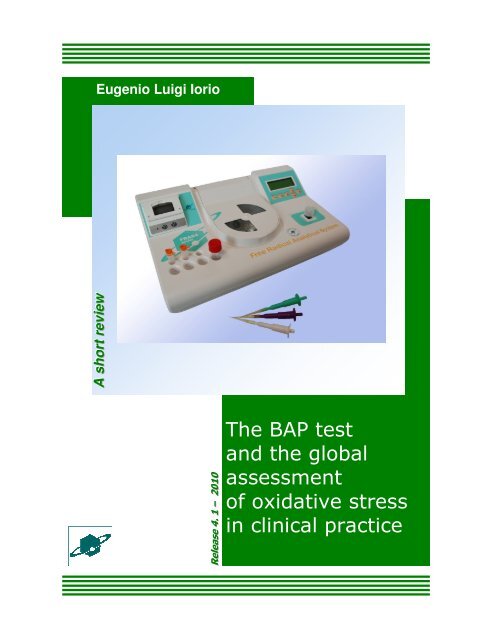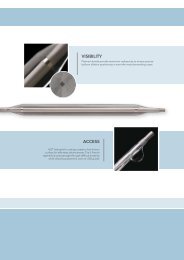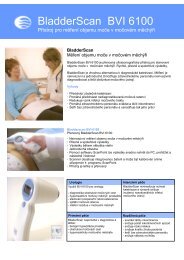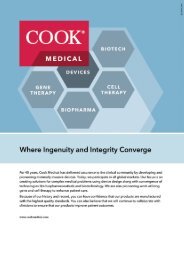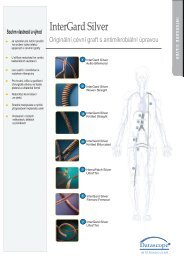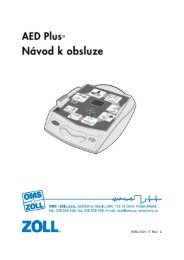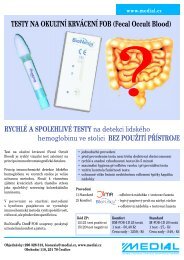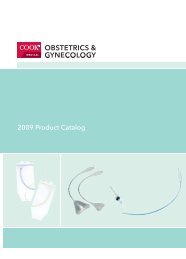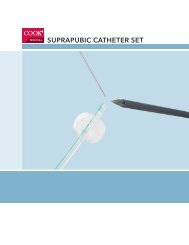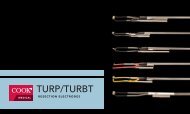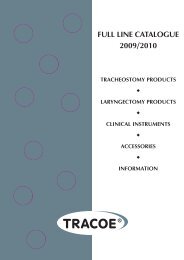The BAP test and the global assessment of oxidative stress ... - Medial
The BAP test and the global assessment of oxidative stress ... - Medial
The BAP test and the global assessment of oxidative stress ... - Medial
Create successful ePaper yourself
Turn your PDF publications into a flip-book with our unique Google optimized e-Paper software.
Eugenio Luigi IorioA short reviiewRellease 4.. 1 – 2010<strong>The</strong> <strong>BAP</strong> <strong>test</strong><strong>and</strong> <strong>the</strong> <strong>global</strong><strong>assessment</strong><strong>of</strong> <strong>oxidative</strong> <strong>stress</strong>in clinical practice
2www.fras4evolvo.it
Table <strong>of</strong> ContentsPreface <strong>and</strong> acknowledgments P. 41 Introduction p. 52 Principle p. 63 Validation <strong>and</strong> comparative studies p. 84 Procedure p. 95 Analytical performances p. 106 Interpretation <strong>of</strong> results p. 127 Clinical studies on Humans p. 138 Clinical studies on Animals p. 169 Experimental studies in vitro p. 1710 Indications <strong>and</strong> clinical usefulness p. 1711 Concluding remarks p. 18References P. 19Info P. 243www.fras4evolvo.it
Antioxidants play a relevant role in <strong>the</strong> biochemical homeostasis <strong>of</strong> our body by defendingour cells <strong>and</strong> tissues against potentially toxic chemical oxidants species, including free radicals <strong>and</strong>reactive oxygen species (ROS).<strong>The</strong>refore, in <strong>the</strong> light to prevent/to treat <strong>the</strong> possible unwanted effects <strong>of</strong> <strong>oxidative</strong> <strong>stress</strong>,many peoples currently take antioxidant supplements with <strong>the</strong> aim to restore <strong>and</strong>/or to maintainan optimal level <strong>of</strong> antioxidant defense effectiveness.However recent studies <strong>and</strong> clinical experience suggest that any antioxidant supplementshould be taken only after a biochemical evidence <strong>of</strong> its deficiency. Indeed high doses <strong>of</strong> someantioxidants may result pro-oxidant.On <strong>the</strong>se basis, in order to establish <strong>the</strong> clinical indications for antioxidant treatment <strong>and</strong> toavoid concomitantly <strong>the</strong> unwanted side effects <strong>of</strong> unneeded supplements, some years ago <strong>the</strong>Italian researcher Mauro Carratelli developed a new <strong>test</strong>, i. e. <strong>the</strong> <strong>BAP</strong> <strong>test</strong>, where <strong>the</strong> initials meanBiological Antioxidant Potential. This <strong>test</strong> is based on <strong>the</strong> ability <strong>of</strong> a plasma blood sample toreduce ferric ions to ferrous ions as a FRAP assay (ferric reducing ability <strong>of</strong> plasma). Howevercompared to <strong>the</strong> classical FRAP assay firstly described by Benzie, <strong>BAP</strong> <strong>test</strong> appears quicker <strong>and</strong>simpler to perform. Moreover according to <strong>the</strong> novel concept <strong>of</strong> <strong>global</strong> <strong>oxidative</strong> <strong>stress</strong> <strong>assessment</strong>,<strong>the</strong> <strong>BAP</strong> <strong>test</strong> showed able to integrate <strong>the</strong> results <strong>of</strong> <strong>the</strong> d-ROMs <strong>test</strong>, which allows <strong>the</strong> <strong>assessment</strong><strong>of</strong> serum/plasma total oxidant capacity.<strong>The</strong> aim <strong>of</strong> <strong>the</strong> present book was to describe <strong>the</strong> principle, <strong>the</strong> validation <strong>and</strong> <strong>the</strong> clinicalapplication <strong>of</strong> <strong>BAP</strong> <strong>test</strong> in Human <strong>and</strong> Veterinary Medicine.We acknowledge <strong>the</strong> help <strong>of</strong> all Authors <strong>of</strong> clinical <strong>and</strong> experimental studies reported in thisbook <strong>and</strong>, particularly, Mauro Carratelli, <strong>the</strong> “inventor” <strong>of</strong> <strong>BAP</strong> <strong>test</strong>.Dr. Eugenio Luigi Iorio, MD, PhD<strong>The</strong> President <strong>of</strong> InternationalObservatory <strong>of</strong> Oxidative Stress4www.fras4evolvo.it
1. Introduction<strong>The</strong> blood <strong>of</strong> Vertebrates contains severalcompounds/activities which are able, takentoge<strong>the</strong>r, to oppose <strong>the</strong> oxidant potential <strong>of</strong>oxidant chemical species, like <strong>the</strong> reactiveoxygen species (ROS) (1).Virtually, any “endogenous” compound (i.e. albumin, transferrin, ceruloplasmin, bilirubin,uric acid, reduced glutathione, etc.) or“exogenous” biomolecule (i. e. tocopherols,carotens, ubiquinol, ascorbate, methionine,flavonoids, polyphenols, etc.) which is able togive equivalent reducing units (e. g. electrons)is able also to block <strong>the</strong> potential damage <strong>of</strong>ROS. Indeed, <strong>the</strong> reactivity <strong>of</strong> a free radical isjust <strong>the</strong> result <strong>of</strong> a lack <strong>of</strong> electrons (2).Of course, any injury to such “blood barrierto oxidation” – e. g. exposure ei<strong>the</strong>r toradiations, or xenobiotics or infectious agents –can result in <strong>oxidative</strong> tissue damage <strong>and</strong>,<strong>the</strong>refore, in early aging <strong>and</strong> in <strong>the</strong> so-called<strong>oxidative</strong> <strong>stress</strong> related diseases (e. g.a<strong>the</strong>rosclerosis, arterial hypertension, stroke,myocardial infarction, diabetes, arthritis,dementia, colitis, pancreatitis, respiratorydiseases, cancer, infections, etc.) (3).<strong>The</strong> velocity <strong>of</strong> <strong>the</strong>se processes can beslowed down not only by specificpharmaco<strong>the</strong>rapies (e. g. antihypertensive orlipid-lowering drugs), but also by modifyingsome lifestyles (e. g. diet, exercise, etc.) <strong>and</strong>,when indicated, by <strong>the</strong> intake <strong>of</strong> compoundswith antioxidant activity (4).However, before any medical intervention,<strong>the</strong> antioxidant effectiveness <strong>of</strong> plasma barrierto oxidation should be assessed, in order tolimit <strong>the</strong> eventual intake <strong>of</strong> antioxidants only topatients showing a reduced antioxidant plasmaactivity (5). In fact, an uncontrolled intake <strong>of</strong>antioxidants has been shown to induce aparadoxical unwanted pro-oxidant action (6,7).<strong>The</strong>refore, <strong>the</strong> <strong>assessment</strong> <strong>of</strong> antioxidantactivity <strong>of</strong> plasma/serum blood is <strong>the</strong> first step<strong>of</strong> any medical intervention aimed to redress<strong>the</strong> <strong>oxidative</strong> balance in <strong>oxidative</strong> <strong>stress</strong> relatedconditions.Over <strong>the</strong> last few years, a number <strong>of</strong> <strong>test</strong>sbased on different chemical principles has beenproposed in order to assess <strong>the</strong> wholeantioxidant activity <strong>of</strong> plasma or serum blood(5, 8-18).In this subject, one <strong>of</strong> <strong>the</strong> most knowexamples <strong>of</strong> oxidation in Nature is <strong>the</strong> change<strong>of</strong> iron from ferrous to ferric form, as it happenin <strong>the</strong> generation <strong>of</strong> <strong>the</strong> rust. <strong>The</strong>refore onecan consider as antioxidant a solution, such <strong>the</strong>serum/blood plasma, which is able to bringback <strong>the</strong> iron from its ferric form to <strong>the</strong> ferrousform.In o<strong>the</strong>r words from <strong>the</strong> merely analyticalpoint <strong>of</strong> view, <strong>the</strong> effectiveness <strong>of</strong> antioxidantplasma barrier can be evaluated by <strong>test</strong>ing itsability to reduce a specific substrate, i. e. byassessing its ability to give oxidant agents (e.g. free radicals) to one or more electrons.For this purpose, several chemicalreducing-oxidizing couples are available. Forinstance, transition metals (i e. iron) exhibit<strong>the</strong> property to receive one electron thusshifting from <strong>the</strong> oxidized state (Fe 3+ ) toreduced state (Fe 2+ ). Such agents can work as“meters” in <strong>test</strong>s aimed to assess antioxidantpower <strong>of</strong> biological systems. Indeed, <strong>the</strong> socalled“plasma antioxidant power” is ultimatelya measure <strong>of</strong> <strong>the</strong> reducing or “electron-giving”activity <strong>of</strong> blood plasma.On <strong>the</strong> o<strong>the</strong>r h<strong>and</strong>, some compounds share<strong>the</strong> ability to change <strong>the</strong>ir absorbance justwhen bound to compounds able to switch from<strong>the</strong> oxidized to reduced state. For instance,some thiocyanates are able to reversibly shiftfrom colored to uncolored derivatives, in <strong>the</strong>presence <strong>of</strong> ferric or ferrous salts, respectively(19). Such “chromogens” can work as excellent“detectors” when coupled with adequate“oxidizing/reducing meters” in a <strong>test</strong> designedto assess antioxidant activity <strong>of</strong> biologicalsamples.Indeed, when a ferric salt is dissolved in auncolored solution containing a particularthiocyanate derivative, <strong>the</strong> resulting solutionbecomes red, as a function <strong>of</strong> <strong>the</strong> ferric ionsconcentration. This phenomenon is ascribableto <strong>the</strong> formation <strong>of</strong> a complex between ferricsalt <strong>and</strong> thiocyanate. Fur<strong>the</strong>r adding <strong>of</strong> a smallamount <strong>of</strong> blood plasma will reduce ferric ions5www.fras4evolvo.it
to ferrous ions thus making uncolored <strong>the</strong>initial red solution. Such a chromatic change –may be due to <strong>the</strong> release <strong>of</strong> ferrous ions by<strong>the</strong> colored thiocyanate complex – can be readby means <strong>of</strong> a photometer, previously set at<strong>the</strong> wavelength <strong>of</strong> chromogen.<strong>The</strong>refore, <strong>the</strong> entity <strong>of</strong> absorbance changewill directly correlate with <strong>the</strong> antioxidant“potential” <strong>of</strong> blood plasma against <strong>the</strong> specificsubstrate which has been used asoxidant/detector (ferric ions). In o<strong>the</strong>r words,<strong>the</strong> ability <strong>of</strong> <strong>the</strong> <strong>test</strong>ed plasma to reduce ferricto ferrous ions may provide a direct measure<strong>of</strong> <strong>the</strong> ability <strong>of</strong> a sample <strong>of</strong> such plasma togive reducing equivalents <strong>and</strong> <strong>the</strong>n neutralizechemical species lacking <strong>of</strong> electrons, like ROS– obviously in <strong>the</strong> reduction-oxidation potentialrange <strong>of</strong> chosen oxidant-reducing couple(Fe 3+ /Fe 2+ ).On <strong>the</strong> basis <strong>of</strong> this background, a novel<strong>test</strong>, aimed to assess <strong>the</strong> antioxidant plasmaactivity, has been recently developed by <strong>the</strong>Italian Chemist Mauro Carratelli <strong>and</strong> firstdescribed by Dohi et al. (20).This <strong>test</strong> has been called “<strong>BAP</strong>” <strong>test</strong> whichinitials underline that <strong>the</strong> assay is designed toassess <strong>the</strong> Biological Antioxidant Potential <strong>of</strong>blood plasma.<strong>The</strong> aim <strong>of</strong> this short review is to present<strong>the</strong> principle, <strong>the</strong> validation, <strong>the</strong> procedure, <strong>the</strong>indications <strong>and</strong> clinical usefulness <strong>of</strong> <strong>the</strong> <strong>BAP</strong><strong>test</strong> in <strong>the</strong> light <strong>of</strong> <strong>the</strong> available literature.2. Principle<strong>BAP</strong> <strong>test</strong> is based on <strong>the</strong> ability <strong>of</strong> a coloredsolution, containing a source <strong>of</strong> ferric (Fe 3+ )ions adequately bound to a specialchromogenic substrate, to decolour when Fe 3+ions are reduced to ferrous ions (Fe 2+ ), as itoccurs by adding a reducing/anti-oxidantsystem, i. e. a blood plasma sample (20).<strong>The</strong>refore, in <strong>the</strong> <strong>BAP</strong> <strong>test</strong>, a small amount<strong>of</strong> blood plasma (10 µL) to be <strong>test</strong>ed isdissolved in a colored solution, which has beenpreviously obtained by mixing a source <strong>of</strong>ferric ions (i. e. ferric chloride, FeCl 3 , <strong>the</strong> R 2reagent) with a special chromogenic substrate(i. e. a thiocyanate derivative, <strong>the</strong> R 1 reagent)(19).After a short incubation (5 min), at 37 °C,such solution will decolor <strong>and</strong> <strong>the</strong> intensity <strong>of</strong>this chromatic change will be directlyproportional to <strong>the</strong> ability <strong>of</strong> plasma to reduce,during <strong>the</strong> incubation, ferric ions (initiallyresponsible for <strong>the</strong> color <strong>of</strong> solution) to ferrousions, according to <strong>the</strong>se reactions:1. FeCl 3 + AT (uncolored) → FeCl 3 – AT (colored)2. FeCl 3 –AT (colored) + BP (e-) → FeCl 2 + AT (uncolored) + BPwhere:• FeCl 3 is ferric chloride;• AT (uncolored) is a thiocyanate derivative (uncolored);• FeCl 3 – AT (colored) is <strong>the</strong> colored complex <strong>of</strong> ferricchloride with <strong>the</strong> thiocyanate derivative;• BP (e-) is a molecule <strong>of</strong> blood plasma barrier withreducing/electron giving/antioxidant activityagainst ferric ions;• BP is <strong>the</strong> oxidized form <strong>of</strong> BP (e-) ;• FeCl 2 is <strong>the</strong> ferrous chloride obtained by <strong>the</strong>reducing activity <strong>of</strong> BP (e-) .By assessing photometrically <strong>the</strong> intensity<strong>of</strong> decoloration, <strong>the</strong> amount <strong>of</strong> reduced ferricions can be adequately evaluated thus allowingan effective measurement <strong>of</strong> reducing ability orantioxidant potential <strong>of</strong> <strong>test</strong>ed blood plasma(20).Such a “potential” is obviously not absolutebut relative to <strong>the</strong> <strong>test</strong>ed substrate, i. e. ferricions. Considering that such ions are naturallyoccurring components <strong>of</strong> <strong>the</strong> body, <strong>BAP</strong> <strong>test</strong>,as its initials suggest (Biological AntioxidantPotential), provides a reliable measure <strong>of</strong>antioxidant power <strong>of</strong> <strong>the</strong> fraction <strong>of</strong> plasmabarrier to oxidation which is directly involved –due to <strong>the</strong> implicated reducing-oxidantpotentials – against <strong>the</strong> attack <strong>of</strong> reactivechemical species in “physiological” or“biological” conditions.However, since <strong>the</strong> main aim <strong>of</strong> <strong>BAP</strong> <strong>test</strong> isto provide a <strong>global</strong> <strong>assessment</strong> <strong>of</strong> antioxidantdefenses <strong>of</strong> our body, no studies has beenperformed in order to establish <strong>the</strong> exactcontribution to <strong>the</strong> assay <strong>of</strong> eachserum/plasma blood antioxidants, whichamount should be detected by means <strong>of</strong>6www.fras4evolvo.it
different analytical approach (e. g. massspectrometry, chromatography <strong>and</strong> so on).In any case by considering that <strong>BAP</strong> <strong>test</strong>exploits <strong>the</strong> same principle <strong>of</strong> FRAP assay (21)i. e. <strong>the</strong> reduction <strong>of</strong> ferric to ferrous ions, it islikely that <strong>BAP</strong> <strong>test</strong> measures <strong>the</strong> sameantioxidants <strong>of</strong> any assay based on ironreduction (Table 1).µEq/L1600120080040000 10 50 100µg/mLTable 1. Relative activity <strong>of</strong> individual plasmaantioxidants <strong>and</strong> <strong>the</strong>ir estimated contributions tototal ferric reducing activity <strong>of</strong> plasma (modified byBenzie et al, 1996) (21).PlasmaantioxidantsRelativeActivity 1Expectedplasma level 2Estimatedcontribution 3Uric acid 2.0 (2.0-2.4) 150 – 450 60Ascorbic acid 2.0 (1.9-2.1) 30 – 100 15Proteins 0.1(0.1-0.15) 800 – 1100 10α-Tocopherol 2.0 (1.7-2.1) 15 – 40 5Bilirubin 4.0 (4.2-4.6) < 20 5O<strong>the</strong>rs – – 51 Measured range. 2 Fasting concrentrations (µmol/L). 3 Tototal iron-reducing plasma activity.Indirect evidence that <strong>BAP</strong> <strong>test</strong> measuresat least some <strong>of</strong> <strong>the</strong>se antioxidants has beenprovided by some experiments performedei<strong>the</strong>r on st<strong>and</strong>ard solutions or blood plasmasamples.For instance <strong>BAP</strong> <strong>test</strong> was able to detect invitro <strong>the</strong> antioxidant potency <strong>of</strong> uric acid (UA)as ferric reducing capacity in solutionscontaining increasing amounts <strong>of</strong> UA (22)(Figure 1).µEq/L1600120080040000 10 20 30mg/dLFigure 1. Effects <strong>of</strong> aqueous solutions <strong>of</strong> uric acid(UA) on <strong>BAP</strong> <strong>test</strong> in vitro. For each concentrationUA in aqueous solution, <strong>BAP</strong> was measured threetimes, <strong>and</strong> values are presented as means ± SD. Alldifferences among solutions were statisticallysignificant (P
<strong>The</strong> result <strong>of</strong> a clinical study on hyperbaric<strong>the</strong>rapy seems to confirm this hypo<strong>the</strong>sis (23)(see below, clinical studies on Humans <strong>and</strong>Figure 11 ). In any case <strong>BAP</strong> <strong>test</strong> was able todetect in vitro increased amounts <strong>of</strong> bilirubin aminor iron-reducing agent (20) (Figure 4).10000µEq/L5000400030002000R=0.7µEq/L80006000400020000Control 0.1 0.5 1.0 2.0 5.0Bilirubin (mg/dL)Figure 4. Effects <strong>of</strong> solutions <strong>of</strong> bilirubin on <strong>BAP</strong><strong>test</strong> in vitro (modified by Dohi et Al, 2005) (20).Finally, experiments ex-vivo performed onhuman plasma showed a direct <strong>and</strong> significantcorrelation between <strong>BAP</strong> <strong>test</strong> values <strong>and</strong> α-tocopherol levels (24) (Figure 5).00 2 4 6 8 10 1214µMFigure 5. Correlation between <strong>BAP</strong> <strong>test</strong> values <strong>and</strong>α-tocopherol concentration in a sample <strong>of</strong> rat bloodplasma (modified by Dohi et al, 2007) (24).Taken toge<strong>the</strong>r <strong>the</strong> evidence now availableindicates that <strong>BAP</strong> <strong>test</strong> provides a reliablemeasure <strong>of</strong> all <strong>the</strong> antioxidant plasmacompounds/activities able to reduce ferric ionsto ferrous ions including UA, AsA, bilirubin <strong>and</strong>α−tocopherol, as previously described for FRAPassay (21) (see also below, paragraph 3).3. Validation <strong>and</strong> comparative studies<strong>The</strong> validation <strong>of</strong> <strong>BAP</strong> <strong>test</strong> has beenachieved by means <strong>of</strong> experiments performedwith <strong>the</strong> Electron Spin/ParamagneticResonance Spectrometry (ESR/EPR) that isconsidered <strong>the</strong> “golden st<strong>and</strong>ard” technique tostudy free radicals ex vivo.According to its principle, <strong>BAP</strong> <strong>test</strong> providesan evaluation <strong>of</strong> <strong>the</strong> whole antioxidant capacity<strong>of</strong> blood plasma, measured as reducingpotential against ferric ions.Several compounds may contribute to this“biological antioxidant potential” <strong>of</strong> whomsome – like bilirubin (see Table 1) – exhibits a“scavenger” activity against free radicals,having <strong>the</strong> ability to neutralize directly freeradicals.On <strong>the</strong>se basis, an ESR/EPR studyperformed showed that <strong>the</strong> bilirubin exhibits“in vitro” direct scavenging activity againstei<strong>the</strong>r <strong>the</strong> hydroxyl radical (HO • ), <strong>the</strong> mostpotentially dangerous oxygen free radicals inliving organisms, or <strong>the</strong> 1,1-diphenylpicrylhydrazyl radical already atphysiological conditions (20).In experiments performed in parallel with<strong>the</strong> <strong>BAP</strong> <strong>test</strong> it was shown that <strong>the</strong> results <strong>of</strong>both assays (as conducted ei<strong>the</strong>r by ESR/EPRor photometry) overlapped (20) (Figure 6).Figure 6. Comparison between photometric <strong>BAP</strong>assay (histograms) <strong>and</strong> Electron Spin ResonanceSpectrometry (ESR/EPR) (box): increasingconcentrations <strong>of</strong> bilirubin are able to increase <strong>BAP</strong><strong>test</strong> values (because bilirubin acts anantioxidant/iron reducing compound) <strong>and</strong> to reduceconcomitantly ESR/EPR signal (because bilirubinacts as a scavenger against hydroxyl radical)(modified by Dohi et al, 2005) (20).By considering that ESR/EPR is <strong>the</strong>reference technique to study <strong>the</strong> free radicals,<strong>BAP</strong> <strong>test</strong> must be considered, thanks to thisauthoritative validation, a <strong>test</strong> really able todetect <strong>and</strong> quantify in a specific <strong>and</strong> suitablemanner scavenging/antioxidant activities, as aconfirmation <strong>of</strong> <strong>the</strong> above proposed principle <strong>of</strong>its mechanism.8www.fras4evolvo.it
On <strong>the</strong> o<strong>the</strong>r h<strong>and</strong>, in experimental trials, ithas been shown that <strong>the</strong> <strong>BAP</strong> resultssatisfyingly correlate with those <strong>of</strong> FRAP, whichis considered <strong>the</strong> comparison method <strong>the</strong> mostsimilar to <strong>BAP</strong> <strong>test</strong>, in <strong>the</strong> actual panorama <strong>of</strong>all <strong>the</strong> assays proposed to evaluate <strong>the</strong> plasmaantioxidant capacity.Indeed, <strong>the</strong> FRAP assay is based on <strong>the</strong>reduction <strong>of</strong> ferric tripyridyltriazine (Fe III -TPTZ)to ferrous tripyridyltriazine (Fe II -TPTZ), whichdevelops an intense blue color, phometricallymeasurable by setting <strong>the</strong> wavelength to 593nm (21). <strong>The</strong> calibration may be performed bymeans <strong>of</strong> solutions with known concentrations<strong>of</strong> Fe II (FeSO 4 . 7H 2 O). Analogously, <strong>the</strong> <strong>BAP</strong> <strong>test</strong>is based on <strong>the</strong> use <strong>of</strong> a colored solution whichis obtained by adding a source <strong>of</strong> ferric ions toa chromogenic mixture.<strong>The</strong> entity <strong>of</strong> decoloration is <strong>the</strong>n assessedby measuring <strong>the</strong> absorbance at 505 nm,which is proportional to <strong>the</strong> reducing activity <strong>of</strong><strong>the</strong> sample.According to <strong>the</strong>se observations, Vassalle(unpublished data) recently assessedcomparatively analytical performance <strong>of</strong> <strong>BAP</strong><strong>and</strong> FRAP <strong>test</strong> on 18 samples <strong>of</strong> human bloodplasma.According to <strong>the</strong> result <strong>of</strong> this study, meanvalue (± SD) <strong>of</strong> <strong>BAP</strong> <strong>test</strong> was 3163±770 µEq/L,while <strong>the</strong> mean value (± SD) <strong>of</strong> FRAP <strong>test</strong> was521±132 µmol/L.<strong>The</strong> correlation between <strong>test</strong> was shown tobe acceptable in 16/18 <strong>test</strong>ed sample(88.89%).<strong>The</strong> remaining two samples were shown tonot correlate, maybe to <strong>the</strong> higher level <strong>of</strong>plasma lipids, which can interfere with <strong>the</strong>photometric readings <strong>of</strong> every photometric <strong>test</strong>(Figure 7).FRAP <strong>test</strong> (µmol/L)FRAP (µmol/l)80070060050040030020010001500 2000 2500 3000 3500 4000 4500<strong>BAP</strong> <strong>test</strong> (µEq/L)Figure 7. Comparative evaluation <strong>of</strong> <strong>BAP</strong> <strong>test</strong> <strong>and</strong>FRAP assay (modified by Vassalle et al, 2006)(Unpublished data).4. Procedure<strong>BAP</strong> <strong>test</strong> can be performed ei<strong>the</strong>r onwhole blood or heparinised blood plasma orserum. Such samples should be fresh, in orderto avoid an eventual underestimation <strong>of</strong> <strong>the</strong>results due to possible auto-oxidationphenomena.<strong>The</strong>refore, while waiting fur<strong>the</strong>r data bystudies in progress, it is suggested tocentrifuge as soon as possible (within 1 hour)<strong>the</strong> blood <strong>and</strong> to recover plasma or serum. If<strong>the</strong> sample (plasma/serum) cannot beimmediately processed it should be stored at+4 °C <strong>and</strong> <strong>test</strong>ed within 1-to-3 days oraccording to <strong>the</strong> guidelines <strong>of</strong> laboratory goodpractice.However very recent evidence suggeststhat <strong>BAP</strong> <strong>test</strong> maintains its analytical reliabilityeven on previous frozen samples (at -80°C)<strong>The</strong> <strong>BAP</strong> <strong>test</strong> can be performed with acommon photometer, according to <strong>the</strong> exactst<strong>and</strong>ardized work conditions (Table 2).Table 2. Work conditions <strong>of</strong> <strong>BAP</strong> <strong>test</strong>.Wavelenght Optical path Temperature Mode505 nm 1 cm 37 °C DifferentialHowever, due to some practical reasons,<strong>the</strong> <strong>test</strong> can be performed also with dedicatedanalytical devices, like FREE system (DIACRONInternational s. r. l., Grosseto, Italy) (24), forblood plasma or serum, or FRAS 4 system(H&D s. r. l., Parma, Italy) (20) by startingform whole (capillary) blood. Both systems,which require dedicated kits, substantially limitmanual intervention to a few steps comparedto common photometers, thus reducing apossible source <strong>of</strong> analytical imprecision.Moreover, ei<strong>the</strong>r FREE or FRAS systemallows a <strong>global</strong> <strong>assessment</strong> <strong>of</strong> <strong>oxidative</strong> <strong>stress</strong>,due to <strong>the</strong> possibility to perform not only <strong>the</strong><strong>BAP</strong> <strong>test</strong> (antioxidant status <strong>assessment</strong>) butalso <strong>the</strong> d-ROMs <strong>test</strong> (oxidant status<strong>assessment</strong>) (20, 24).9www.fras4evolvo.it
<strong>The</strong> FREE system is an “open” systemconsisting <strong>of</strong> a photometer <strong>and</strong> a dry<strong>the</strong>rmostating block. Both <strong>the</strong> tools aremanaged by a computerized system able toreceive, to elaborate <strong>and</strong> to export <strong>the</strong> data.<strong>The</strong> initials FREE means Free Radical ElectiveEvaluator, i. e. system for <strong>the</strong> elective study <strong>of</strong>free radicals.<strong>The</strong> dedicated kit <strong>of</strong> <strong>the</strong> <strong>BAP</strong> <strong>test</strong> for FREEcontains cuvettes ready-to-use with a solution<strong>of</strong> a thiocyanate derivative (R 1 reagent) <strong>and</strong> avial <strong>of</strong> ferric chloride (R 2 reagent).According to <strong>the</strong> procedure for <strong>the</strong> FREEsystem, at least 10 min before <strong>the</strong> analyticalsession, it is preferable to seat <strong>the</strong> cuvettes,ready to use for analysis, in <strong>the</strong> <strong>the</strong>rmostatedhousing <strong>of</strong> instrument. It is also very importantto bring <strong>the</strong> reagents to working temperaturebefore <strong>the</strong> use.When ready, <strong>the</strong> operator must select,through <strong>the</strong> keyboard <strong>of</strong> instrument, <strong>the</strong> presetchannel.For each analytical series, <strong>the</strong> procedureinvolves, before <strong>test</strong>ing plasma or serum, <strong>the</strong>zeroing <strong>and</strong> <strong>the</strong> subsequent automaticsubtraction <strong>of</strong> reagent blank absorbance.Practically, after having adjusted <strong>the</strong> zeroagainst distilled water in <strong>the</strong> photometer, 50 µL<strong>of</strong> R 2 reagent (ferric chloride) is transferredinto <strong>the</strong> cuvette containing <strong>the</strong> R 1 reagent (athiocyanate derivative). <strong>The</strong> resulting coloredsolution, after gently mixing by inversion,undergoes photometric reading. <strong>The</strong>n, 10 µL <strong>of</strong>sample is added in <strong>the</strong> same cuvette <strong>and</strong> <strong>the</strong>obtained solution is gently mixed <strong>and</strong>incubated into <strong>the</strong> <strong>the</strong>rmostatic block for 5 minat 37 °C. After incubation, <strong>the</strong> sample can beread for absorbance.FRAS 4 is a new integrated analyticalsystem consisting <strong>of</strong> a dedicated photometerwith incorporate centrifuge designed to allowfor <strong>the</strong> <strong>global</strong> <strong>assessment</strong> <strong>of</strong> <strong>oxidative</strong> <strong>stress</strong>on whole blood, by means <strong>of</strong> two <strong>test</strong>s, i. e. d-ROMs <strong>test</strong> <strong>and</strong> <strong>BAP</strong> <strong>test</strong>. <strong>The</strong> initials FRASmeans Free Radical Analytical System, i. e.system for <strong>the</strong> analytical study <strong>of</strong> free radicals.<strong>The</strong> most innovative technological feature<strong>of</strong> FRAS 4 is <strong>the</strong> integration <strong>of</strong> centrifuge with<strong>the</strong> analytical module. This system enables <strong>the</strong>operator to perform not only <strong>the</strong>centrifugation but also <strong>the</strong> photometricanalysis.<strong>The</strong> dedicated kit <strong>of</strong> <strong>BAP</strong> <strong>test</strong> for FRAS 4 issimilar to that one <strong>of</strong> FREE system; moreover,it contains also <strong>the</strong> tools for taking <strong>the</strong> wholeblood from a finger.Practically, a small amount <strong>of</strong> plasma (10µL), which has been obtained after centrifuging<strong>the</strong> whole blood sample (100-150 µL), isdissolved in <strong>the</strong> colored solution, previouslyprepared by mixing <strong>the</strong> R 2 reagent (FeCl 3 ) withR 1 reagent (a thiocyanate derivative). After 5min <strong>of</strong> incubation at 37 °C, <strong>the</strong> solutionundergoes photometric reading.To periodically calibrate FREE <strong>and</strong> FRAS 4systems, a lyophilized human control serum isavailable with a known antioxidant titleexpressed as µmol/L.Both devices directly provide <strong>the</strong> results <strong>of</strong><strong>the</strong> <strong>BAP</strong> <strong>test</strong> – that is <strong>the</strong> “biologicalantioxidant potential” <strong>of</strong> plasma – asµEquivalents/L (µEq/L) (by using ascorbate asiron reducing agent).Data <strong>of</strong> Producer from healthy individualsindicated initially that <strong>the</strong> optimal value <strong>of</strong> <strong>BAP</strong><strong>test</strong> should be higher than 2.200 µEq/L. <strong>The</strong>studies performed in <strong>the</strong> last 3 yearssubstantially confirmed this statement (seebelow), although every laboratory shoulddetermine its own reference value.5. Analytical performancesAnalytical performances were initiallyevaluated with a first set <strong>of</strong> experiments onst<strong>and</strong>ard solutions <strong>of</strong> ascorbic acid (AsA) withknown values, by using a FREE equipment(Diacron International, Grosseto, Italy), inorder to establish <strong>the</strong> lowest limits <strong>of</strong> detection<strong>and</strong> quantification, respectively, <strong>and</strong> linearity.<strong>The</strong> lowest detection limit, i. e. <strong>the</strong> lowestconcentration <strong>of</strong> a signal that can bedistinguished by <strong>the</strong> blank (as calculated bymultiplying 3 times <strong>the</strong> st<strong>and</strong>ard deviation, asobtained by <strong>the</strong> average <strong>of</strong> 10 replicatedanalyses <strong>of</strong> <strong>the</strong> blank) was 118 (mean value).<strong>The</strong> lowest quantification limit, i. e. <strong>the</strong> lowest10www.fras4evolvo.it
In particular, 140 Labrador Retriever dogs,75 females <strong>and</strong> 55 males, between 1 <strong>and</strong> 5years old, fed with <strong>the</strong> same super-premiumdry food <strong>and</strong> with <strong>the</strong> same lifestyle, wereincluded in a study (25). All <strong>the</strong> subjects werein good health conditions at <strong>the</strong> physical <strong>and</strong>laboratory examination (haemogram,biochemical pr<strong>of</strong>ile, urine analysis <strong>and</strong> serumprotein electrophoresis) (25).<strong>The</strong> <strong>BAP</strong> <strong>test</strong> showed linear in <strong>the</strong> <strong>test</strong>edinterval (Figure 9), with a 0,95 “r” coefficient.µEq/L2500.002000.001500.001000.00500.00R 2 =0.950.000 20 40 60 80 100 120%Figure 9. Linearity <strong>of</strong> <strong>BAP</strong> <strong>test</strong> (data from canineplasma) (modified by Pasquini et al, 2008) (25).<strong>The</strong> recovery values <strong>of</strong> accuracy turned out106,41%. <strong>The</strong> within-run CV WAS 6,4 %, while<strong>the</strong> between-run CV was 8,1% (25). <strong>The</strong>sedifferences, compared to <strong>the</strong> lower data shownin Humans, can be at least partially ascribableto pre-analytical errors. In fact, preliminaryreports on rats indicate that <strong>the</strong> intake <strong>of</strong> food<strong>and</strong>/or antioxidants significantly increases <strong>the</strong>basal value <strong>of</strong> <strong>the</strong> <strong>BAP</strong> <strong>test</strong>. <strong>The</strong>refore, it ism<strong>and</strong>atory to perform <strong>the</strong> <strong>BAP</strong> <strong>test</strong> in <strong>the</strong> samepre-analytical conditions <strong>of</strong> o<strong>the</strong>r biochemical<strong>test</strong>s, like blood glucose (<strong>the</strong> morning, at rest).This should significantly decrease anyvariability <strong>of</strong> <strong>the</strong> <strong>BAP</strong> <strong>test</strong> even in <strong>the</strong> sameindividual.Taken toge<strong>the</strong>r, <strong>the</strong>se findings indicate that<strong>the</strong> <strong>BAP</strong> <strong>test</strong> shows good to excellent analyticalperformances as a reliable tool to assessantioxidant status in blood samples ei<strong>the</strong>r fromHumans or Animals.<strong>The</strong>se performances were shown improvedrecently by automating <strong>the</strong> <strong>test</strong> on a multipleanalyzer (OLYMPUS 450) (data submitted forpublication).Interestingly, <strong>BAP</strong> <strong>test</strong> showed excellentrepeatability on o<strong>the</strong>r biological matrices, likewater-soluble antioxidant formulas, with anintra-assay coefficient <strong>of</strong> variation 1.9% (seebelow, Studies in Vitro).At <strong>the</strong> moment, <strong>the</strong> only describedinterfering factor as well as for all photometricassays is a very high blood level <strong>of</strong> lipids (seebelow).6. Interpretation <strong>of</strong> resultsAccording to <strong>the</strong> data <strong>of</strong> <strong>the</strong> Producer(Diacron International, Grosseto, Italy), <strong>the</strong>“optimal value” <strong>of</strong> <strong>BAP</strong> <strong>test</strong> in healthy peoplesshould be at least 2.200 µEq/L.Benedetti et al. confirmed this finding, byshowing values 2169 ± 105 µEq/L on plasmablood samples (n=12) from apparently healthypeoples, selected among a more largepopulation <strong>of</strong> healthy blood donors(unpublished data).Noticeably <strong>the</strong>se values are very similar to<strong>the</strong>se very recently reported by Nagata et al. in50 healthy volunteers (2137 ± 228 µEq/L)(26).<strong>The</strong>refore, <strong>the</strong> normal range proposed by<strong>the</strong> producer is substantially confirmed by<strong>the</strong>se preliminary data (see also below, ClinicalStudies on Humans).In o<strong>the</strong>r words, values lower than 2.200µEq/L indicate a reduced “biological potential”<strong>and</strong> hence a decreased effectiveness <strong>of</strong> <strong>the</strong>antioxidant plasma barrier, according to anarbitrary scale <strong>of</strong> severity (Table 5).Table 5. <strong>BAP</strong> <strong>test</strong> results <strong>and</strong> antioxidant barrierimpairment.<strong>BAP</strong> <strong>test</strong> results Impairment degree <strong>of</strong>(µEq/L) plasma antioxidant barrier2.200 – 2.000 Border line condition2.000 – 1.800 Slight reduction1.800 – 1.600 Moderate reduction1.600 – 1.400 Strong reduction< 1.400 Very strong reductionOptimal value > 2.200 µEq/L12www.fras4evolvo.it
Preliminary data also suggests that elderlypeoples have results <strong>of</strong> <strong>the</strong> <strong>BAP</strong> <strong>test</strong> lower thanhealthy adults (unpublished data).Interestingly, dogs showed a normal rangevery similar to that one <strong>of</strong> Humans (2446 ±585 µEq/L) with a normal-like distribution <strong>of</strong> allvalues, ranging from 1440 to 3260 µEql/L (25)(Table 6).Table 6. Referral range <strong>of</strong> <strong>BAP</strong> <strong>test</strong> in dogs(modified by Pasquini et al, 2008) (25).Unitsµmol/LKurtosis – 1.4Skewness – 0.2Media 2466Mediana 2610SD 585Reference range 1440 – 32607. Clinical studies on Humans<strong>The</strong> clinical usefulness <strong>of</strong> <strong>the</strong> <strong>BAP</strong> <strong>test</strong> inHumans bas been demonstrated in severalstudies, ei<strong>the</strong>r in physiological or pathologicalconditions. Most <strong>of</strong> <strong>the</strong>se papers wereperformed by coupling d-ROMs <strong>test</strong> with <strong>BAP</strong><strong>test</strong>. However, because this short review isfocused on <strong>BAP</strong> <strong>test</strong> we will describeparticularly clinical studies on this <strong>test</strong> with areference to d-ROMs <strong>test</strong> when indicated.Due to <strong>the</strong> close relationships betweenoxygen pressure <strong>and</strong> <strong>oxidative</strong> <strong>stress</strong>preliminary studies evaluated <strong>BAP</strong> <strong>test</strong> inconditions mimicking hyperoxia.It has been suggested that hyperbaricoxygen (HBO) causes <strong>oxidative</strong> <strong>stress</strong> through<strong>the</strong> production <strong>of</strong> reactive oxygen metabolites,as also detected by d-ROMs <strong>test</strong> (27). Howeversome patients with decompression illness (DCI)need repeated HBO treatments which can leadto concerns about an accumulation <strong>of</strong> <strong>oxidative</strong><strong>stress</strong> (28). <strong>The</strong>refore 9 DCI patients wereexposed to two session <strong>of</strong> U. S. NavyTreatment Table 6 at an interval <strong>of</strong> 3 days(23). <strong>BAP</strong> significantly increased after <strong>the</strong> 1 st<strong>and</strong> after <strong>the</strong> 2 nd HBO compared with before 1 stHBO (23) (Figure 10).µEq/L25002000150010005000P
µEq/L25002000150010005000Before divingP
specific advise on lifestyle <strong>the</strong> score <strong>of</strong> aspecific visual analogical scale (VAS) for fatiguesignificantly increase with a trend to <strong>BAP</strong>increased values (although <strong>the</strong> change did notreach <strong>the</strong> statistical significance cut-<strong>of</strong>f) (36).No significant changes were noted in <strong>the</strong>results <strong>of</strong> <strong>the</strong> <strong>BAP</strong> <strong>test</strong> after acupuncture inspite <strong>of</strong> <strong>the</strong> decrease <strong>of</strong> d-ROMs <strong>test</strong> values(37) while Japanese females suffering fromhypotension showed increase values <strong>of</strong> <strong>BAP</strong><strong>test</strong> (38).Postmenopausal women also showedsignificantly higher <strong>BAP</strong> <strong>test</strong> values comparedto men in a clinical trial performed onmetabolic syndrome (2531±323 µEq/L vs.2345±245 µEq/L, respectively; P
8. Clinical studies on AnimalsGrowing evidence suggest <strong>the</strong> potentialusefulness <strong>of</strong> <strong>BAP</strong> <strong>test</strong> in <strong>the</strong> monitoring <strong>of</strong><strong>oxidative</strong> <strong>stress</strong> in different animal species,including rats, mice, piglets <strong>and</strong> dogs (44).In particular, liver regeneration afterhepatectomy was followed in rats by asignificant decrease <strong>of</strong> <strong>BAP</strong> values, may be dueto <strong>the</strong> concomitant increase <strong>of</strong> d-ROMs <strong>test</strong>values (45) (Figure 17).µEq/LFigure 17. Changes in <strong>BAP</strong> <strong>test</strong> values afterhepatectomy in rats. Values are reported as mean± SD. P values
9. Experimental studies in vitroA recent challenge for antioxidantsupplements is <strong>the</strong> determination <strong>of</strong>antioxidant power in vitro. Indeed in <strong>the</strong> lightto develop new formulas, <strong>the</strong> producer whenpossible should report on <strong>the</strong> label at least anindication on <strong>the</strong> ability <strong>of</strong> <strong>the</strong> formula toneutralize effectively one or more oxidants.Among <strong>the</strong> available assays <strong>BAP</strong> <strong>test</strong>proven useful in <strong>the</strong> <strong>assessment</strong> <strong>of</strong> antioxidantcapacity <strong>of</strong> some formulas destined to patientsor healthy peoples (Table 7).Table 7. <strong>BAP</strong> <strong>test</strong> values <strong>of</strong> some antioxidant formulasFormulas <strong>BAP</strong> <strong>test</strong> values N CV (%)GIN PENT TM (1) 48500±2880 9 4.1DEUTROSULFAZYME TM (2) 64747± 3660 8 5.7DEUTROSULFAZYME TM (3) 235500± 9161 8 3.9DEUTROSULFAZYME TM (4) 274500± 6009 8 2.2ARAMEN TM (5) 22440 ± 908 7 4.0<strong>BAP</strong> <strong>test</strong> values are expressed as mean µEq/L±SD. N is<strong>the</strong> number <strong>of</strong> determinations. CV is <strong>the</strong> within-runcoefficient <strong>of</strong> variation. (1) Gimnostemma pentaphyllumplus fermented papaya plus reduced glutathione (2)Deutrosulfazyme TM basic formula. (3) Deutrosulfazyme TMvitamin C-enriched formula. (4) Deutrosulfazyme TMmultivitamins-enriched formula. (5) Herbal product basedon Laminaria digitata, Condrus crispus, Sambucus nigra,Vaccinium myrtillus, Rosa canina <strong>and</strong> Feniculus vulgareMiller.Among <strong>the</strong>se was also Deutrosulfazyme TM(CELLFOOD TM , NUSCIENCE CORPORATION,US) a non-addictive, non-invasive, <strong>and</strong>completely non-toxic proprietary colloidal-ionicformula containing finest all-natural, plantbasedorganic substances like ionic minerals,enzymes, amino acids <strong>and</strong> deuterium sulphateas traces (51, 52).More recently <strong>BAP</strong> <strong>test</strong> was performedcomparatively on samples <strong>of</strong> h<strong>and</strong>-made beersagainst to industrial beers(Table 8) (Bianchi<strong>and</strong> Iorio, unpublished data).Table 8. <strong>BAP</strong> <strong>test</strong> values <strong>and</strong> polyphenols levels inh<strong>and</strong>-made <strong>and</strong> industrial beers.Beer <strong>BAP</strong> <strong>test</strong> values* Polyphenols levels**Label 1 10035 583Label 2 9750 517Label 3 9655 631Label 4 9645 904Label 5 10375 700Label 6 7280 477Label 7 9515 451Label 8 11040 938Label 9 9860 629Label 10*** 6080 316*As µEq/L. **As mg catechin/kg. ***IndustrialInterestingly h<strong>and</strong> made beers showedhigher values <strong>of</strong> both <strong>BAP</strong> <strong>test</strong> <strong>and</strong> polyphenolscompared to industrial beers. Noticeably <strong>BAP</strong><strong>test</strong> values correlated with polyphenolscontent.10. Indications <strong>and</strong> clinical usefulness<strong>The</strong> <strong>BAP</strong> <strong>test</strong>, by exploiting <strong>the</strong> samechemical principle <strong>of</strong> <strong>the</strong> well-known FRAP <strong>test</strong>– i. e. <strong>the</strong> reduction <strong>of</strong> ferric to ferrous ions –provides a reliable measure <strong>of</strong> biologicalantioxidant potential <strong>of</strong> blood plasma (53).<strong>The</strong>refore, <strong>the</strong> <strong>BAP</strong> <strong>test</strong> should beperformed with <strong>the</strong> aim <strong>of</strong> assessing <strong>the</strong>antioxidant status ei<strong>the</strong>r in healthy peoples, inorder to prevent <strong>oxidative</strong> <strong>stress</strong>, or in patientswith <strong>oxidative</strong> <strong>stress</strong>-related diseases, in orderto monitor <strong>the</strong> efficacy <strong>of</strong> specific <strong>and</strong>/orantioxidant <strong>the</strong>rapies (54, 55).All healthy peoples should undergo <strong>the</strong> <strong>BAP</strong><strong>test</strong> because all <strong>the</strong> individuals are potentiallyexposed to <strong>the</strong> risk <strong>of</strong> producingexaggerate amounts <strong>of</strong> free radicals, aphenomenon which requires a very effectiveantioxidant barrier. Indeed, <strong>the</strong> primary aim <strong>of</strong>this <strong>test</strong> is to identify <strong>and</strong> to prevent <strong>oxidative</strong><strong>stress</strong> <strong>and</strong> its unwanted consequences (earlyaging, diseases) (56).All <strong>the</strong> more so, <strong>the</strong> <strong>BAP</strong> <strong>test</strong> should besystematically performed on all clinicallyasymptomatic subjects, who are exposed for anumber <strong>of</strong> reasons to factors able to reducephysiological antioxidant plasma defenses (e.g. inadequate exercise, unbalanced diet,chronic inflammatory diseases with reduced17www.fras4evolvo.it
absorption <strong>of</strong> nutrients, etc.). In <strong>the</strong>se casesalso, <strong>the</strong> aim <strong>of</strong> <strong>the</strong> <strong>BAP</strong> <strong>test</strong> is to identify <strong>and</strong>to prevent <strong>oxidative</strong> <strong>stress</strong> <strong>and</strong> its unwantedconsequences (early aging, diseases) (57).Moreover, <strong>the</strong> <strong>BAP</strong> <strong>test</strong> should be carriedout on all patients with <strong>oxidative</strong> <strong>stress</strong>-relateddiseases (more than one hundred), such asAlzheimer’s disease, Parkinson’s disease,stroke, infarction, Crohn’s diseases, rheumatoidarthritis, AIDS, some cancers, etc. In all <strong>the</strong>secases, <strong>the</strong> aim <strong>of</strong> <strong>the</strong> <strong>BAP</strong> <strong>test</strong> is to monitor<strong>oxidative</strong> <strong>stress</strong> <strong>and</strong> to prevent itsconsequences, by monitoring <strong>the</strong> efficacy <strong>of</strong>specific <strong>the</strong>rapy, ei<strong>the</strong>r alone or with aconcomitant antioxidant treatment (54). Onthis subject, it must be underlined that in many<strong>of</strong> above mentioned diseases, all almost havinga chronic course, <strong>oxidative</strong> <strong>stress</strong> tends toraise <strong>the</strong> role <strong>of</strong> an additional health riskfactor. <strong>The</strong>refore, it must be controlled in orderto optimize results <strong>of</strong> any treatment. Forinstance, <strong>the</strong> evidence, by means <strong>of</strong> <strong>BAP</strong> <strong>test</strong>,<strong>of</strong> a reduced biological antioxidant potential inhypertensive patients indicates a persistentimpairment <strong>of</strong> physiological defenses againstROS, which can be responsible for anincomplete control <strong>of</strong> <strong>the</strong> current disease by<strong>the</strong> current anti-hypertensive treatment. Sucha finding suggests to <strong>the</strong> clinician an integrated<strong>the</strong>rapeutic approach, in which should be takeplace not only conventional, medical <strong>and</strong>/orsurgical treatments, but also <strong>the</strong> correction <strong>of</strong>life-style <strong>and</strong>, eventually, <strong>the</strong> intake <strong>of</strong>antioxidants.Finally, ideal c<strong>and</strong>idates for <strong>the</strong> <strong>BAP</strong> <strong>test</strong>are all <strong>the</strong> subjects that undergopharmaco<strong>the</strong>rapy (e. g. with chemo<strong>the</strong>rapeuticals,hormone replacement <strong>the</strong>rapy,contraceptive pill, etc.), surgical interventions(e. g. organ transplantation, by-pass, etc.),including dialysis, all conditions being able t<strong>of</strong>avor <strong>oxidative</strong> <strong>stress</strong> by increasing <strong>the</strong> dailyrequirements <strong>of</strong> antioxidants (53, 54).In all <strong>the</strong>se conditions, <strong>the</strong> aim is toidentify <strong>and</strong> to prevent <strong>oxidative</strong> <strong>stress</strong> <strong>and</strong> itsconsequences, <strong>and</strong>, particularly, to monitor <strong>the</strong>efficacy <strong>of</strong> eventual current measures with <strong>the</strong>ultimate objective <strong>of</strong> preventing <strong>oxidative</strong>tissue damage (56).Fur<strong>the</strong>rmore, according to <strong>the</strong> guidelines <strong>of</strong><strong>the</strong> International Observatory <strong>of</strong> OxidativeStress, Free Radicals <strong>and</strong> Antioxidant Systems,<strong>the</strong> <strong>BAP</strong> <strong>test</strong> is very useful, toge<strong>the</strong>r d-ROMs<strong>test</strong>, in <strong>the</strong> so-called <strong>global</strong> <strong>assessment</strong> <strong>of</strong><strong>oxidative</strong> <strong>stress</strong>, now very easy to performgrace to a specific diagnostic algorithm (41,58).In this situation, when d-ROMs value isincreased, an optimal value <strong>of</strong> <strong>BAP</strong> <strong>test</strong> shouldrequire <strong>the</strong> dosing <strong>of</strong> a single antioxidant.Alternatively, if such a dosing is not available,we suggest a mix <strong>of</strong> antioxidants according to<strong>the</strong> RDA tables. This should enable <strong>the</strong>antioxidant defenses to balance <strong>the</strong> increased<strong>oxidative</strong> status, as detected by <strong>the</strong> increasedd-ROMs <strong>test</strong> values, especially when more thanone risk factor is present (e. g. exposition toradiations, cigarette smoke, pollutants, etc.).11. Concluding remarksScientific evidence shows that <strong>BAP</strong> <strong>test</strong> isvery useful in <strong>the</strong> <strong>assessment</strong> <strong>of</strong> antioxidantactivity <strong>of</strong> blood plasma. AAccording to <strong>the</strong> wide available scientificliterature <strong>BAP</strong> <strong>test</strong> was validated by ESR/EPR<strong>and</strong> provided results that largely parallel tothose <strong>of</strong> FRAP <strong>test</strong>, against which it appearsquicker <strong>and</strong> simpler to perform. Indeed, <strong>the</strong>preparation <strong>and</strong> management <strong>of</strong> <strong>the</strong> FRAPreagents is a step somewhat complex,compared to that <strong>of</strong> <strong>BAP</strong> <strong>test</strong>, so that manualprocedure <strong>of</strong> FRAP <strong>test</strong> can increase analyticalvariability. Moreover, a fur<strong>the</strong>r increase <strong>of</strong>analytical accuracy was recently reached by<strong>the</strong> application <strong>of</strong> <strong>BAP</strong> <strong>test</strong> to automaticanalytical devices.Finally, according to <strong>the</strong> novel concept <strong>of</strong><strong>global</strong> <strong>oxidative</strong> <strong>stress</strong> <strong>assessment</strong>, <strong>the</strong> <strong>BAP</strong><strong>test</strong> is a reliable assay able to integrate <strong>the</strong>results <strong>of</strong> d-ROMs <strong>test</strong>, which allows for <strong>the</strong>assessing <strong>of</strong> <strong>the</strong> total oxidant status <strong>of</strong> bloodplasma.18www.fras4evolvo.it
References1. Halliwell B, Gutteridge JMC. Free radicals inbiology <strong>and</strong> medicine. 2 nd Edn, ClarendonPress, Oxford. 1989.2. Cadenas E, Packer L. H<strong>and</strong>book <strong>of</strong>antioxidants. Marcel Dekker, Inc. 1996.3. Halliwell B, Gutteridge JMC, Cross CE. Freeradicals, antioxidants, <strong>and</strong> human disease:where are we now? J Clin Lab Med. 1992.119: 598–620.4. Valko M, Leibfritz D, Moncol J, Cronin MT,Mazur M, Telser J. Free radicals <strong>and</strong>antioxidants in normal physiological functions<strong>and</strong> human disease. Int J Biochem Cell Biol.2007. 39 (1): 44–84.5. Cao G, Prior RL. Comparison <strong>of</strong> differentanalytical methods for assessing totalantioxidant capacity <strong>of</strong> human serum. ClinicalChemistry. 1998. 44 (6): 1309–1315.6. Olson J L. Benefits <strong>and</strong> liabilities <strong>of</strong> vitamin A<strong>and</strong> carotenoids. J Nutr. 1996. 126: 1208S–1212S.7. Schwartz JL. <strong>The</strong> dual role <strong>of</strong> nutrients asantioxidants <strong>and</strong> prooxidants: <strong>the</strong>ir effect ontumor cell growth. J Nutr. 1996. 126: 1221S–1227S8. Wayner DDM, Burton GW, Ingold KU, LockeS. Quantitative measurement <strong>of</strong> <strong>the</strong> total,peroxyl radical-trapping antioxidant capacity <strong>of</strong>human blood plasma by controlledperoxidation. FEBS Lett. 1985. 187: 33–7.9. Glazer AN. Phycoerythrin fluorescence-basedassay for reactive oxygen species. MethodsEnzymol. 1990. 186. 161–8.10. Cao G, Alessio HM, Cutler RG. Oxygenradicalabsorbance capacity assay forantioxidants. Free Rad Biol Med. 1993.14:303–11.11. Cao G, Verdon CP, Wu AHB, Wang H, PriorRL. Automated oxygen radical absorbance19capacity assay using <strong>the</strong> COBAS FARA II. ClinChem. 1995. 41: 1738–44.12. Rice-Evans C, Miller NJ. Total antioxidantstatus in plasma <strong>and</strong> body fluids. MethodsEnzymol. 1994. 234: 279–93.13. Miller NJ, Rice-Evans C, Davies MJ,Gopinathan V, Milner A. A novel method formeasuring antioxidant capacity <strong>and</strong> itsapplication to monitoring <strong>the</strong> antioxidant statusin premature neonates. Clin Sci. 1993. 84:407–12.14. Ghiselli A, Serafini M, Maiani G, Assini E,Ferro-Luzzi A. A fluorescence-based method formeasuring total plasma antioxidant capability.Free Rad Biol Med. 1994. 18: 29–36.15. Whitehead TP, Thorpe GHG, Maxwell SRJ.Enhanced chemiluminescent assay forantioxidant capacity in biological fluids. AnalChim Acta. 1992. 266: 265–77.16. Trotti R, Carratelli M, Barbieri M, Micieli G,Bosone D, Rondanelli P, Bo P. Oxidative <strong>stress</strong><strong>and</strong> thrombophilic condition in alcoholicswithout severe liver disease. 2001.Haematologica. 86: 85-91.17. Carratelli M, Porcaro R, Ruscica M, DeSimone E, Bertelli AAE, Corsi MM. ReactiveOxygen Metabolites (ROMs) <strong>and</strong> prooxidantstatus in children with Down Syndrome.International Journal <strong>of</strong> Clinical PharmacologyResearch. 2001. 21 (2): 79-84.18. Brambilla G, Fiori M, Archetti LI. Evaluation<strong>of</strong> <strong>the</strong> <strong>oxidative</strong> <strong>stress</strong> in growing pigs bymicroplate assays. J Vet Med A. 2001. 48: 33-38.19. MERCK CHEMICAL Database. 2003.20. Dohi K, Satoh K, Ohtaki H, Shioda S,Miyake Y, Shindo M, Aruga T. Elevated plasmalevels <strong>of</strong> bilirubin in patients with neurotraumareflect its pathophysiological role in free radicalscavenging. In Vivo. 2005. 19 (5): 855–860.www.fras4evolvo.it
21. Benzie IFF, Strain JJ. <strong>The</strong> ferric reducingability <strong>of</strong> plasma (FRAP) as a measure <strong>of</strong>“antioxidant power”: <strong>the</strong> FRAP assay. AnalBiochem. 1996. 239: 70-76.22. Nakayama K, Terawaki H, Nakayama M,Iwabuchi M, Sato T, Ito S. Reduction <strong>of</strong> serumanti<strong>oxidative</strong> capacity during haemodialysis.Clin Exp Nephrol. 2007. 11: 218–224.23. Kongoji J, Yamami N, Togawa S, Suzuki N,Yamamoto K, Mano Y. Indexes <strong>of</strong> <strong>oxidative</strong><strong>stress</strong> during HBO treatment. ProceedingsUndersea <strong>and</strong> Hyperbaric Medical Society.Scientific Meeting & Associates/BNA. AnnualScientific Meeting. 22-24 June 2007. Orl<strong>and</strong>o,Florida (USA). 2007. P 112.24. Dohi K, Satoh K, Nakamachi T, Y<strong>of</strong>u S,Hiratsuka K, Nakamura S, Ohtaki H, YoshikawaT, Shioda S, Aruga T. Does Edaravone (MCI-186) act as an antioxidant <strong>and</strong> aneuroprotector in experimental traumatic braininjury? Antioxid. Redox Signal. 2007. 8: 281–287.25. Pasquini A, Luchetti E, Marchetti V, CardiniG, Iorio EL. Analytical performances <strong>of</strong> d-ROMs<strong>test</strong> <strong>and</strong> <strong>BAP</strong> <strong>test</strong> in canine plasma. Definition<strong>of</strong> <strong>the</strong> normal range in healthy Labrador dogs.Vet Res Commun. 2008. 32 (2): 137–143.26. Nagata K, Hasegawa T, Hirokado Y,Kiyama K, Otsuki C. Lifestyle-related diseases<strong>and</strong> <strong>the</strong> <strong>oxidative</strong> <strong>stress</strong> regulation system. JpnJ Psychosom Med. 2008. 4(3): 176-183.27. Benedetti S, Lamorgese A, Piersantelli M,Pagliarani S, Benvenuti F, Canestrari F.Oxidative <strong>stress</strong> <strong>and</strong> antioxidant status inpatients undergoing prolonged exposure tohyperbaric oxygen. Clinical Biochemistry.2004. 37: 312–317.28. Klingmann C, Gonnermann A, Dreyhaupt J,Vent J, Praetorius M, Plinkert PK.Decompression illness reported in a survey <strong>of</strong>429 recreational divers. Aviat Space EnvironMed. 2008. 79(2):123–128.29. Buonocore G, Perrone S, Longini M, VezzosiP, Marzocchi B, Paffetti P, Bracci R. Oxidative<strong>stress</strong> in preterm neonates at birth <strong>and</strong> on <strong>the</strong>seventh day <strong>of</strong> life. Pediatric Research. 2002.52 (1): 46–49.30. Ezaki S, Kurishima C, Suzuki K, Kondo T,Tamura M. Resuscitation <strong>of</strong> preterm infantswith reduced concentration <strong>of</strong> inspired oxygen.Proceedings 11 th Annual Congress PerinatalSociety <strong>of</strong> Australia <strong>and</strong> New Zeal<strong>and</strong> (PSANZ2007). 2007. April, 1–4. Melbourne ConventionCentre. Melbourne, Victoria (Australia). 2007.31. Yamami N, Nakayama H, Kongoji J,Togawa S, Nozawa T, Yagishita K, ShibayamaM, Nakayama T, Suzuki N, Yamamoto K,Kawashima M, Mano Y. Free radicals <strong>and</strong>antioxidant potential in scuba divers.Proceedings Undersea <strong>and</strong> Hyperbaric MedicalSociety. Scientific Meeting & Associates/BNA.Annual Scientific Meeting. 22-24 June 2007.Orl<strong>and</strong>o, Florida (USA). 2007. P 98–99.32. Giganti MG, Iorio EL, Verna R, Zenobi R.Oxidative balance in scuba divers. Journal <strong>of</strong>Molecular <strong>and</strong> Clinical Pathology. 2007. 3:101.33. Zazryn TR, Finch CF, McCrory P. A 16 yearstudy <strong>of</strong> injuries to pr<strong>of</strong>essional kickboxers in<strong>the</strong> state <strong>of</strong> Victoria, Australia. Br J Sports Med.2003. 37:448–51.34. Cavallini M, Iorio EL. Effect <strong>of</strong> training <strong>and</strong>antioxidant supplementation on <strong>oxidative</strong>balance in martial arts. Journal <strong>of</strong> Molecular<strong>and</strong> Clinical Pathology. 2007. 2: 14-15.35. Karlsson J. Antioxidants <strong>and</strong> exercise.Human Kinetics. 1997.36. Nagata K, Kasuya N, Hayashi H. Oxidative<strong>stress</strong> <strong>and</strong> anti-oxidant potential <strong>of</strong> <strong>the</strong>students complaining chronic fatigue. CampusHealth. 2006. 43 (2): 83-88.37. Hirokado Y, Nagata K, Aoyama Y, KiyamaK, Okano K, Hasegawa. Prohomeostatic effects<strong>of</strong> acupuncture. 2006. International CongressSeries. 2006. 1287: 107–110.38. Hasegawa T. Oxidative <strong>stress</strong> <strong>and</strong>antioxidant potential in Japanese females withhypotension. Proceedings 19 th World Congress20www.fras4evolvo.it
<strong>of</strong> Psychosomatic Medicine. Québec City(Québec) Canada. 2007. August 26–31. 2007.P 30.39. Tsuchiya M, Tosaka M. <strong>The</strong>re is a genderdifference in <strong>the</strong> relationship betweenmetabolic syndrome <strong>and</strong> <strong>oxidative</strong> <strong>stress</strong>among Japanese. Clinical Report. 2005.Masako Medical Clinic, Tokuyama, Japan.40. Nagata K, Hasegawa T, Kiyama K, AoyamaY, Okano K, Hirokado Y. A <strong>the</strong>rapy forfibromyalgia syndrome using Yi-Gan San.Journal <strong>of</strong> Japanese Association <strong>of</strong> OrientalPsychosomatic Medicine. 2006. 21 (1-2): 46–47.41. Iorio EL. A diagnostic algorithm to manage<strong>oxidative</strong> <strong>stress</strong> (original title “Un algoritmodiagnostico per la gestione dello <strong>stress</strong>ossidativo”). Proceedings InternationalCongress <strong>of</strong> Antiaging Medicine. 2006,Starhotels Business Palace, 20 th May. Milan.2006.42. Pober BR, Morris CA. Diagnosis <strong>and</strong>management <strong>of</strong> medical problems in adultswith Williams-Beuren syndrome. Am J MedGenet C Semin Med Genet. 2007. 145(3):280-290.43. Komatsu F, Kudoh H, Kagawa Y. Evaluation<strong>of</strong> <strong>oxidative</strong> <strong>stress</strong> <strong>and</strong> effectiveness <strong>of</strong> lowdoseglucocorticoid <strong>the</strong>rapy on exacerbation <strong>of</strong>chronic obstructive pulmonary disease. Journal<strong>of</strong> Gerontology. 2007. 62A (4): 459–464.44. Iorio EL. Oxidative <strong>stress</strong> <strong>assessment</strong> inAnimals. Actuality <strong>and</strong> perspectives [originaltitle “La valutazione dello <strong>stress</strong> ossidativo neglianimali. Attualità e prospettive”]. Proceedings“67° Convegno Nazionale Unione ZoologicaItaliana”. Napoli (Italy). 2006, September12 nd -15 th . Pp. 28.45. Han SY, Chang EJ, Choi HJ, Nam SI, LeeNH, Kwak CS, Park SB, Kim HC, Mun KC. Totalantioxidant status <strong>and</strong> oxygen free radicalsduring hepatic regeneration. TransplantationProceedings. 2006. 38: 2214–2215.46. Fujiwara T, Nakabayashi M, Goto M,Koyama S, Fujimoto A, Kugu K, Yano T,Tsutsumi O, Taketani Y, Okamoto T.Preliminary study on action <strong>of</strong> coenzyme Q 10 infemale reproductive system. Proceedings 5 thConference <strong>of</strong> <strong>the</strong> International Coenzyme Q 10Association. 2007. November 9 to 12. KobeGakuin University at Port Isl<strong>and</strong>. Kobe, Japan.2007. JP-039 (1–2).47. Kakita H, Hussein Mh, Daoud Ga, Kato T,Murai H, Sugiura T, Mizuno K, Yamada Y, ItoT, Fukuda S, Kato I, Suzuki S, Togar H. Totalhydroperoxide <strong>and</strong> biological antioxidantpotentials in a neonatal sepsis model. PediatricResearch. 2006. 60 (6): 675–679.48. Cardini G, Pasquini A, Luchetti E, MarchettiV, Voltini B. Free radicals oxygen (d-ROMs <strong>test</strong>)<strong>and</strong> Biological Antioxidant Potential (<strong>BAP</strong> <strong>test</strong>)<strong>assessment</strong> in serum: dog’s reference ranges[original title “La determinazione dei radicaliliberi dell’ossigeno (d-ROMs <strong>test</strong>) e delpotenziale antiossidante biologico (<strong>BAP</strong> <strong>test</strong>)nel siero: intervalli di riferimento nella speciecanina”]. Proceedings LIX Convegno Nazionale– Società Italiana delle Scienze VeterinarieViareggio (Italy). 2005, 21 – 24 September.2005. 331–332.49. Pasquini A, Luchetti E, Cardini G. Oxidative<strong>stress</strong> <strong>and</strong> recovery <strong>of</strong> hunting dogs [originaltitle: “Stress ossidativo e tempi di recupero nelcane da caccia”]. Annali Fac Med Vet. 2006.LIX: 229–235.50. Pasquini A, Simonetti P, Luchetti E,Bardana C, Cardini G. <strong>The</strong> Ginkgo biloba in <strong>the</strong>diet <strong>of</strong> ageing dog. [original title “Il Ginkgobiloba nella dieta del cane anziano”]. PraxisVeterinaria. 2005. 26 (2): 1-10.51. EL. Deutrosulfazyme TM (CELLFOOD TM ). Aclinical pharmacological overview [original titleDeutrosulfazyme ® (CELLFOOD ® ). Overviewclinico-farmacologica].ProceedingsInternational Conference Safety Evaluation <strong>of</strong>Complementary <strong>and</strong> Alternative Medicine.2003. Empoli (Italy). 2003, October 24 – 25.52. Iorio EL, Bianchi L, Storti A.Deutrosulfazyme ® : a powerful antioxidant[original title “Deutrosulfazyme ® : un potenteantiossidante”]. La Medicina Estetica. 2006. 30(1): 115 – 116.21www.fras4evolvo.it
53. Carratelli M, Iorio EL, Bianchi L. Methods tomeasure <strong>the</strong> <strong>oxidative</strong> <strong>stress</strong> [original title“Metodi di misurazione dello <strong>stress</strong>ossidativo”]. ADI Magazine. 2006. 4 (10): 405– 414.54. Iorio EL. Carratelli M, D’Amicantonio T.Oxidative <strong>stress</strong> <strong>and</strong> diseases [original title“Stress ossidativo e malattia”]. ADI Magazine.2006. 4 (10): 399 – 404.55. Pece A, Marchetti M, Pallotti R. <strong>The</strong> freeradicals [original title: “I radicali liberi”]. SOOFTItalia Ed. 2006.56. Iorio EL. Oxidative <strong>stress</strong> <strong>and</strong> ageing[original title “Stress ossidativo e senescenza”].In “Il manifesto della lunga vita. La rivoluzionedella medicina predittiva. Mar<strong>and</strong>ola P, MarottaF. Sperling <strong>and</strong> Kupfer. 2007. 318–322.57. Iorio EL. Oxidative <strong>stress</strong> <strong>and</strong> sport[original title: “Stress ossidativo e sport”].European Journal <strong>of</strong> Health, Sport <strong>and</strong>Nutrition. 2007. 1: 102–103.58. Iorio EL, Cinquanta L, Pisano R. Adiagnostic algorithm to manage <strong>oxidative</strong><strong>stress</strong>. Australasian J Cosmet Surg. 2006. 2(1) : 26-30.59. Bertone M, Rizzo M, Assorgi R, MuscatelloA, Crisostomi S, De Blasis E, Di Giacinto B,Spataro A, Iorio EL. Plasma oxidant <strong>and</strong>antioxidant capacity at rest, after exerciseinduceddehydration, <strong>and</strong> after rehydrationwith an antioxidant drink in elite rowers. MedSport. 2008. 61: 487–495.60. Celi P, Sullivan M, Evans D. <strong>The</strong> stability <strong>of</strong><strong>the</strong> reactive oxygen metabolites (d-ROMs) <strong>and</strong>biological antioxidant potential (<strong>BAP</strong>) <strong>test</strong>s onstored horse blood. <strong>The</strong> Veterinary Journal.2008. Doi:10.1016/j.tvjl.2008.09.018.61. Cesarone MR, Di Renzo A, Erpichi S,Schönlau F, Wilmer JL, Blumenfeld J.Improvement in circulation <strong>and</strong> incardiovascular risk factors with a proprietaryisotonic bi<strong>of</strong>lavonoid formula OPC-3TM.Angiology. 2008. 59(4): 408–414.2262. Costantino M, Filippelli A. Efficacy <strong>of</strong><strong>the</strong>rmal <strong>the</strong>rapy in osteoarthritis [original title“Efficacia della terapia termalenell’osteoartrosi.“]. Eur Med Phys. 2008.44(Suppl. 1 to No. 3): 1–3.63. Di Marco P, Priori A, Finoia MG, Petochi T,Marino G, Lemarié G, Alexis M, Alberti A,Macciantelli D. Plasma totaloxidant/antioxidant status in Dicentrarchuslabrax after exposure to experimental hypoxia,hyperoxia <strong>and</strong> hypercapnia. ComparativeBiochemistry <strong>and</strong> Physiology - Part A:Molecular & Integrative Physiology. 2008.151(1, Suppl 1): S15.64. Du Plessis LH, van der Westhuizen FH,Kotzé HF. <strong>The</strong> protective effect <strong>of</strong> plasmaantioxidants during ozone autohemo<strong>the</strong>rapy.African Journal <strong>of</strong> Biotechnology. 2008. 7(14):2472–2477.65. Ezaki S, Ito T, Suzuki K, Tamura M.Association between total antioxidant capacityin breast milk <strong>and</strong> postnatal age in days inpremature infants. J Clin Biochem Nutr. 2008.42: 133–137.66. Fujimoto H, Katayama K, Hayashi T,Kimura K, Yano T. Effect <strong>of</strong> electroacupunctureon exercise-induced <strong>oxidative</strong> <strong>stress</strong>. ZenNippon Shinkyu Gakkai Zasshi (Journal <strong>of</strong> <strong>the</strong>Japan Society <strong>of</strong> Acupuncture <strong>and</strong> Moxibustion:JJSAM). 2008. 58(2): 203–212.67. Barassi A, Colpi GM, Piediferro G, DogliottiG, Melzi D'Eril GV, Corsi MM. Oxidative <strong>stress</strong><strong>and</strong> antioxidant status in patients with erectiledysfunction. J Sex Med. 2009. DOI:10.1111/j.1743-6109.2009.01279.x68. Buico A, Cassino C, Ravera M, Betta PG,Osella D. Oxidative <strong>stress</strong> <strong>and</strong> total antioxidantcapacity in human plasma. Redox Re. 2009.14(3): 125–131.69. Costantini D, Verhulst S. Does highantioxidant capacity indicate low <strong>oxidative</strong><strong>stress</strong>? Functional Ecology. 2009. 23(3): 506–509.70. Iwabayashi M, Fujioka N, Nomot K,Miyazaki R, Takahashi H, Hibino S, TakahashiY, Nishikawa K, Nishida M, Yonei Y. Efficacywww.fras4evolvo.it
<strong>and</strong> safety <strong>of</strong> eight-week treatment withastaxanthin in individuals screened forincreased <strong>oxidative</strong> <strong>stress</strong> burden. Anti-AgingMedicine. 2009. 6(4): 15–21.71. Kaneko K, Taniguchi N, Tanabe Y, NakanoT, Hasui M, Nozu K. Oxidative imbalance inidiopathic renal hypouricemia. Pediatr Nephrol.2009. 24(4): 869–871.72. Iwata N, Okazaki M, Kamiuchi S, Hibino Y.Protective effects <strong>of</strong> oral administrated ascorbicacid against <strong>oxidative</strong> <strong>stress</strong> <strong>and</strong> neuronaldamage after cerebral ischemia/reperfusion indiabetic rats. J Health Sci. 2009. 56(1). INPRESS.73. L<strong>and</strong>oni G, Mariani E, Oriani G, Donarini C,Guerrerio T, Iorio EL. Improvement <strong>of</strong>antioxidant status in women conventionallytreated for breast cancer after 12 months <strong>of</strong> acow milk whey-based supplementation. Apreliminary study. Mediterranean Journal <strong>of</strong>Nutrition <strong>and</strong> Metabolism. 2009. 2(2): 127-131.athletes. J Sports Med Phys Fitness. 2009.49(1): 122–127.76. Mochizuki T, Amenomori Y, Miyazaki R,Hasegawa T, Watanabe M, Fukuike K, Yonei Y.Evaluation <strong>of</strong> exercise programs at a fitnessclub in female exercise beginners using antiagingmedical indicators. Anti-Aging Medicine.2009. 6(8): 66–78.77. Sakamoto R, Matsubayashi K, Kimura Y,Ishine M, Kosaka Y, Wada T, Wada C,Nakatsuka M, Ishimoto Y, Hirosaki M, KasaharaY, Konno A, Chen W, Fujisawa M, Otsuka K,Nakashima M, Wang H, Dai Q, Yang A, Qiao H,Gao J, Li Z, Zhang Y, Ge R-L, Okumiya K.Comprehensive geriatric <strong>assessment</strong> <strong>of</strong> elderlyhighl<strong>and</strong>ers in Qinghai, China, III: <strong>oxidative</strong><strong>stress</strong> <strong>and</strong> aging in Tibetan <strong>and</strong> Han elderlyhighl<strong>and</strong>ers. Geriatr Gerontol Int. 2009. doi:10.1111/j.1447-0594.2009.00544.x74. M<strong>and</strong>as A, Iorio EL, Congiu MG, BalestrieriC, Mereu A, Cau D, Dessì S, Correli N.Oxidative imbalance in HIV-1 infected patientstreated with antiretroviral <strong>the</strong>rapy. Journal <strong>of</strong>Biomedicine <strong>and</strong> Biotechnology. 2009. ArticleID 749575, 7 pages.doi:10.1155/2009/749575.75. Martarelli D, Pompei P. Oxidative <strong>stress</strong><strong>and</strong> antioxidant changes during a 24-hoursmuntain bike endurance exercise in master23www.fras4evolvo.it
F R A S 4 EVOLVO SYSTEMFREE RADICAL ANALYTICAL SYSTEM<strong>The</strong> ideal tool for <strong>global</strong> <strong>oxidative</strong> <strong>stress</strong> <strong>assessment</strong>in routinary clinical practice“Dedicated” integrated analytical system• Photometer (wavelenght 505 nm)• Peltier dry <strong>the</strong>rmostating system• Incorporated mini-centrifuge• Liquid crystal display• Mini-printer with output3 dedicated kits ready to use for analyses on whole blood• d-ROMs <strong>test</strong>: determination <strong>of</strong> reactive oxygen metabolites (ROMs)• <strong>BAP</strong> <strong>test</strong>: determination <strong>of</strong> biological antioxidant plasma potential• SAT <strong>test</strong>: determination <strong>of</strong> biological antioxidant saliva potentialH & D s. r. l.Strada Langhirano 264/1A – 43124 Parma, ItalyPhone +39 0521 – 462607FAX +39 0521 – 467083e–mail: info@hedsrl.itweb site: www.hedsrl.itwww.fras4evolvo.comDepending on <strong>the</strong> permission <strong>of</strong> <strong>the</strong> Author(s), most abstractsor full texts <strong>of</strong> above reported references are available.Both <strong>the</strong> Editor <strong>and</strong> <strong>the</strong> Author do not answer for eventual errors contained in this paper <strong>and</strong> for <strong>the</strong> improper use <strong>of</strong> its content.24www.fras4evolvo.it


